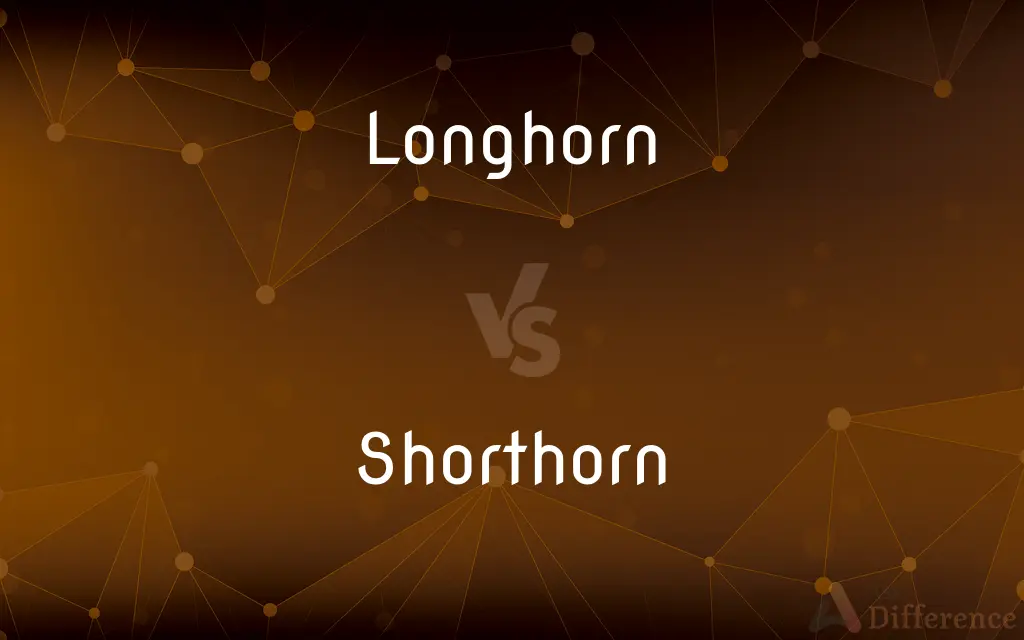Longhorn vs. Shorthorn — What's the Difference?
By Urooj Arif & Fiza Rafique — Updated on April 29, 2024
Longhorn cattle are known for their distinctively long, curved horns and hardy nature, ideal for rugged terrains, whereas Shorthorn cattle are prized for their docile temperament and high-quality beef and dairy production.

Difference Between Longhorn and Shorthorn
Table of Contents
ADVERTISEMENT
Key Differences
Longhorn cattle, originating from the Iberian Peninsula and brought by Spanish settlers to America, are recognized for their impressive horn span, which can extend over six feet from tip to tip. On the other hand, Shorthorn cattle, developed in Northeastern England in the late 18th century, are characterized by their short horns and the ability to adapt to a variety of climates and management systems.
The physical appearance of Longhorns is not only marked by their long horns but also by their diverse color patterns, which can include mixes of red, brown, black, white, and yellow. Whereas Shorthorns typically exhibit red, white, or roan coats, which are highly valued in show rings for their aesthetic appeal.
Longhorn cattle are particularly valued for their resilience and ability to thrive in less fertile areas, making them a popular choice for conservation grazing, which helps maintain natural landscapes. Conversely, Shorthorns are often preferred in agricultural settings for their dual-purpose capabilities, providing both substantial beef yields and significant dairy output.
In terms of temperament, Longhorns are known for their intelligence and independence, traits that have enabled them to survive in tough environments. Shorthorns, however, are renowned for their docility and easy handling, traits that contribute to their popularity among farmers for ease of management and breeding.
When considering commercial use, Longhorn beef is leaner with a distinctive flavor, often marketed as a healthier beef option. Shorthorn cattle, meanwhile, are celebrated for the marbling of their meat, which contributes to flavorful, tender cuts, highly sought after in the culinary world.
ADVERTISEMENT
Comparison Chart
Origin
Iberian Peninsula, via Spanish settlers
Northeastern England
Horns
Long, curved horns over six feet wide
Short horns, not as prominent
Coat Color
Varied, including red, brown, black, white, and yellow
Commonly red, white, or roan
Habitat Adaptation
Hardy, suitable for rugged terrains
Adaptable to various climates
Use
Conservation grazing, lean beef
Dual-purpose: beef and dairy
Temperament
Intelligent, independent
Docile, easy to handle
Meat Quality
Leaner beef
High marbling, tender beef
Compare with Definitions
Longhorn
Display a variety of coat colors.
The Longhorn herd showcased a spectacular array of colors from speckled whites to deep blacks.
Shorthorn
A breed of cattle known for their short horns and high-quality meat.
Shorthorns are often seen at agricultural shows due to their impressive physical build.
Longhorn
A breed of cattle with characteristic long, curved horns.
The rancher admired the majestic Longhorn grazing on his field.
Shorthorn
Suitable for both beef and dairy production.
The farmer uses Shorthorn cattle for both milk production and for beef.
Longhorn
Often used in conservation projects.
Longhorn cattle are employed in conservation grazing to help maintain the natural landscape.
Shorthorn
Adaptable to a variety of farming environments.
Shorthorns thrive well whether in the cold climates of Scotland or the warmer regions.
Longhorn
Known for their hardiness and ability to thrive in tough environments.
Longhorns can easily manage the harsh conditions of the southwestern deserts.
Shorthorn
Produce marbled meat, which is tender and flavorful.
The chef preferred Shorthorn beef for its rich flavor and tenderness.
Longhorn
Produce lean meat with a unique flavor.
The restaurant featured Longhorn beef for its healthier menu options.
Shorthorn
Prized for their docile nature, making them easy to manage.
The ease of handling Shorthorns makes them a favorite among new cattle farmers.
Longhorn
Any of a breed of cattle with long horns and a brown and white coat, developed in England for meat and milk and now rare.
Shorthorn
Any of a breed of beef or dairy cattle that originated in northern England, having short curved horns or no horns and a red, white, or roan coat. Also called Durham2.
Longhorn
A Texas Longhorn.
Shorthorn
Describing cattle that have distinctively short horns.
Longhorn
Any of various cow's milk cheeses, usually Colby or Cheddar, that are molded into a long cylinder and often cut into moon or half-moon shapes for sale.
Shorthorn
One of a breed of cattle, originating in England, with distinctively short horns (in contrast to longhorn cattle).
Longhorn
A breed of beef cattle, having long horns, bred in Texas and other parts of southwest United States.
Shorthorn
One of a breed of large, heavy domestic cattle having short horns. The breed was developed in England.
Longhorn
A long-horned animal, as a cow, goat, or beetle. See Long-horned.
Shorthorn
English breed of short-horned cattle
Longhorn
The Texas longhorn.
Longhorn
Long-horned beef cattle formerly common in southwestern United States
Common Curiosities
How do Longhorn and Shorthorn cattle differ in use?
Longhorns are often used for conservation grazing and lean beef, while Shorthorns are preferred for both beef and dairy production.
What distinguishes Longhorn cattle?
Longhorn cattle are distinguished by their long, curved horns and diverse coat colors.
What is the meat quality of Shorthorn cattle like?
Shorthorn cattle are known for their marbled, tender meat which is highly flavorful.
What are Shorthorn cattle known for?
Shorthorn cattle are known for their short horns, dual-purpose utility for beef and dairy, and their docile nature.
How do Longhorns contribute to conservation?
Longhorns are used in conservation grazing projects to maintain and manage natural landscapes effectively.
What kind of meat do Longhorn cattle provide?
Longhorn cattle provide a leaner, healthier beef option.
Are Longhorn cattle good for novice farmers?
Longhorn cattle might be challenging for novices due to their independent nature.
Why might someone choose Shorthorn cattle for farming?
Their docility and dual-purpose utility make them an excellent choice for both beef and dairy production.
Which breed is better for tough environments?
Longhorn cattle are better suited for tough, rugged environments due to their hardiness.
Can Shorthorn cattle adapt to different climates?
Yes, Shorthorn cattle are adaptable to a variety of climates and farming systems.
Do Shorthorn cattle require special care?
Shorthorn cattle are relatively easy to manage due to their adaptable and docile nature.
Which breed would be better for a mixed-function farm?
Shorthorns, due to their versatility in providing both milk and beef, would be ideal for a mixed-function farm.
What is a significant historical fact about Longhorn cattle?
Longhorn cattle were critical to the cattle drives in the American West, symbolizing rugged survival and the cowboy era.
What are typical coat colors for Longhorn cattle?
Longhorn cattle can have a wide range of colors including red, brown, black, white, and yellow.
Is there a preference in the culinary world between Longhorn and Shorthorn beef?
Culinary preferences vary, but Shorthorn beef is often preferred for its flavor and tenderness.
Share Your Discovery

Previous Comparison
Punishment vs. Spanking
Next Comparison
Birth vs. RebirthAuthor Spotlight
Written by
Urooj ArifUrooj is a skilled content writer at Ask Difference, known for her exceptional ability to simplify complex topics into engaging and informative content. With a passion for research and a flair for clear, concise writing, she consistently delivers articles that resonate with our diverse audience.
Co-written by
Fiza RafiqueFiza Rafique is a skilled content writer at AskDifference.com, where she meticulously refines and enhances written pieces. Drawing from her vast editorial expertise, Fiza ensures clarity, accuracy, and precision in every article. Passionate about language, she continually seeks to elevate the quality of content for readers worldwide.
















































